Intel Unveils New Low-Cost PC Platform: Apollo Lake with 14nm Goldmont Cores
by Anton Shilov on April 15, 2016 6:00 PM EST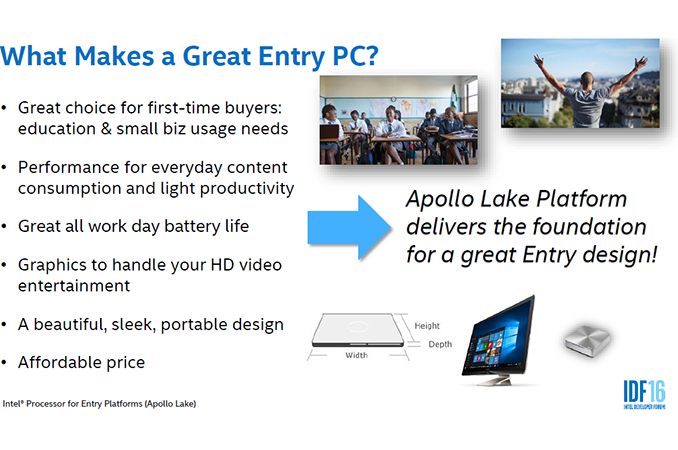
This week, at IDF Shenzhen, Intel has formally introduced its Apollo Lake platform for the next generation of Atom-based notebook SoCs. The platform will feature a new x86 microarchitecture as well as a new-generation graphics core for increased performance. Intel’s Apollo Lake is aimed at affordable all-in-ones, miniature PCs, hybrid devices, notebooks and tablet PCs in the second half of this year.
The Apollo Lake system-on-chips for PCs are based on the new Atom-based x86 microarchitecture, named Goldmont, as well as a new graphics core that features Intel’s ninth-generation architecture (Gen9) which is currently used in Skylake processors. Intel claims that due to microarchitectural enhancements the new SoCs will be faster in general-purpose tasks, but at this stage Intel has not quantified the improvements. The new graphics core is listed as being more powerful (most likely due to both better architecture and a higher count of execution units), but will also integrate more codecs, enabling hardware-accelerated playback of 4K video from hardware decoding of HEVC and VP9 codecs. The SoCs will support dual-channel DDR4, DDR3L and LPDDR3/4 memory, which will help PC makers to choose DRAM based on performance and costs. As for storage, the Apollo Lake will support traditional SATA drives, PCIe x4 drives and eMMC 5.0 options to appeal to all types of form-factors. When it comes to I/O, Intel proposes to use USB Type-C along with wireless technologies with Apollo Lake-powered systems.
| Comparison of Intel's Entry-Level PC and Tablet Platforms | ||||||
| Bay Trail | Braswell | Cherry Trail | Apollo Lake | |||
| Microarchitecture | Silvermont | Airmont | Airmont | Goldmont | ||
| SoC Code-Name | Valleyview | Braswell | Cherryview | unknown | ||
| Core Count | Up to 4 | |||||
| Graphics Architecture | Gen 7 | Gen8 | Gen8 | Gen9 | ||
| EU Count | unknown | 16 | 12/16 | unknown (24?) | ||
| Multimedia Codecs | MPEG-2 MPEG-4 AVC VC-1 WMV9 HEVC (software only) VP9 (software only) |
MPEG-2 MPEG-4 AVC VC-1 WMV9 HEVC (8-bit software/hybrid) VP9 (software/hybrid) |
MPEG-2 MPEG-4 AVC VC-1 WMV9 HEVC VP9 |
|||
| Process Technology | 22 nm | 14 nm | 14 nm | 14 nm | ||
| Launch | Q1 2014 | H1 2015 | 2015 | H2 2016 | ||
From the IDF presentation, Intel shares only a few brief details regarding its new Apollo Lake design platform, but does not disclose exact specifications or performance numbers. At this point, based on 14nm Airmont designs, it is pretty safe to assume that the new SoCs will contain up to four Goldmont cores in consumer devices but perhaps 8+ in communications and embedded systems. Intel has not specified the TDP of its new processors but claims that power management features of the platform will help it to improve battery life compared to previous-gen systems (which might point to a Speed Shift like arrangement similar to what we see on Skylake, perhaps). While Intel does not reveal specifics of its own SoCs, the company shares its vision for the upcoming PCs powered by the Apollo Lake platform.
Firstly, Intel believes that the upcoming affordable PCs, whether these are all-in-one desktops, miniature systems, 2-in-1 hybrids, laptops or tablets, should be very thin. According to their market research, this will make the devices more attractive to the buyer, which is important. To make systems thinner, Intel traditionally proposes to use either M.2 or solder-down eMMC solid-state storage options instead of 2.5” HDDs/SSDs. In addition, the company believes that it makes sense to use solder-down Wi-Fi, instead of using a separate module. Intel seems to be especially proud with the compactness of the Apollo Lake SoC (as well as other core components) and thus the whole platform, which is another factor that will help to make upcoming systems thinner. For the first time in recent years, Intel also proposes the use of smaller batteries, but devices can maintain long battery life by cutting the power consumption of the entire platform. While in many cases reduction of battery size makes sense, it should be noted that high-resolution displays typically consume a lot of energy, which is why it is hard to reduce the size of batteries, but maintain the visual experience along with a long battery life.
Secondly, PCs based on the Apollo Lake should be very affordable, which is why Intel’s reference core components design can be used for different form-factors (AiO and mobile). Additionally, the company reveals a number of BOM (bill of materials) savings opportunities, which are a result of higher level of SoC integration as well as a recommended choice of components. In the slide above, using all the savings can make a difference in BOM for between $5.55 and $7.35, which could mean double memory or a better display for the same price for the new generation.
Intel’s reference design for Apollo Lake-based PCs seems to be a tablet/2-in-1 hybrid system with an 11.6” full-HD (1920x1080) 10-point multi-touch display, 4 GB of LPDDR3-1866 memory, 64 GB M.2 SATA3 SSD or 32 GB eMMC storage, an M.2 wireless module supporting 802.11ac, an optional M.2 LTE modem, an integrated USB 2 camera, a host of sensors (accelerometer, ambient light, proximity detection, and magnetic switching) as well as a USB Type-C connector supporting USB power delivery and alternate modes. Such reference design can power not only mobile, but also Aan IO and even small form-factor desktop PCs. Still, given the fact that we are talking about low-cost systems, do not expect retail computers to feature multiple storage devices and LTE modems. However, PC makers may opt for more advanced displays as well as better integrated cameras, or an SI might plump for a half-price 'Macbook-like' device design using Type-C, albeit on the Atom microarchitecture. This is Intel's vision forthe next generation of Chromebooks: the 'cloud book' market.
PCs based on Intel’s Apollo Lake platforms will emerge in the second half of the year and will carry Celeron and Pentium-branded processors. At present, entry-level notebooks (which Intel calls Cloudbooks) offer 2 GB of memory, 32 GB of storage, 8+ hours of battery life and ~18mm thick designs. With Apollo Lake, OEMs should be able to increase the amount of RAM and/or storage capacity, make systems generally thinner, but maintain their $169 - $269 price-points. Intel also believes that its Apollo Lake presents great opportunities to build 2-in-1 hybrid PCs (convertibles) and capitalize on higher margins of such systems.
Traditionally, Intel discusses options and its vision, but not actual PCs, at its IDF trade-shows. It remains to be seen whether PC makers decide to build low-cost convertibles or ultra-thin notebook designs, or will stick to more traditional clamshell notebooks. In fact, we will learn more about BTS (back-to-school) plans of major PC OEMs regarding Apollo Lake at the upcoming Computex trade-show in early June. There's also IDF San Francisco in August where Intel may open some lids on how the new Goldmont core differs from Airmont.
Source: Intel


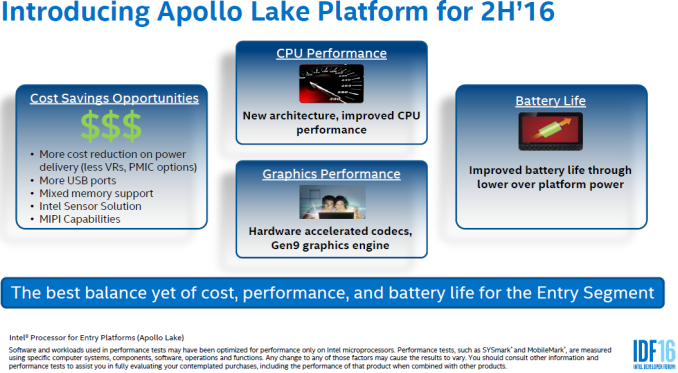
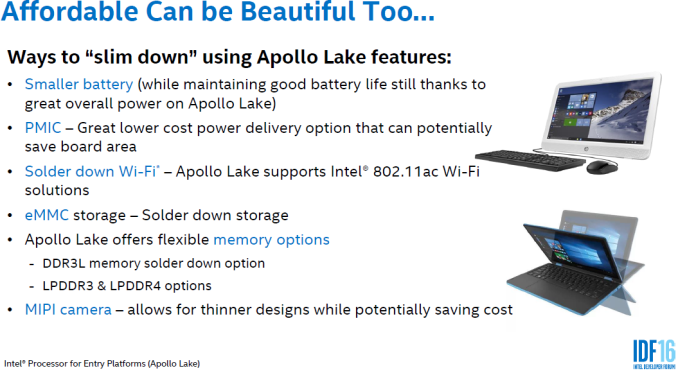
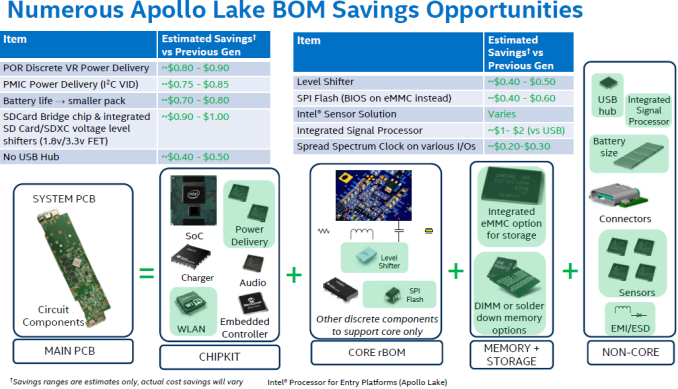
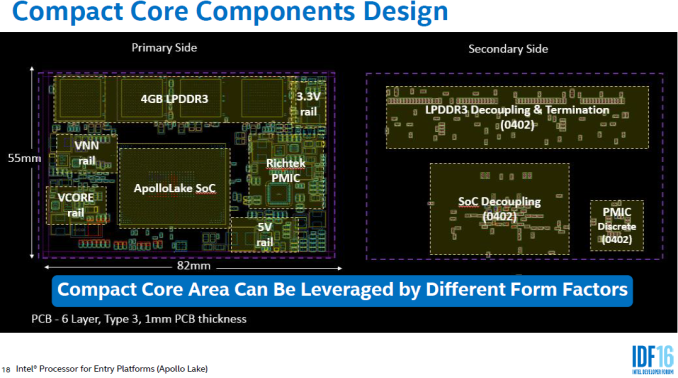
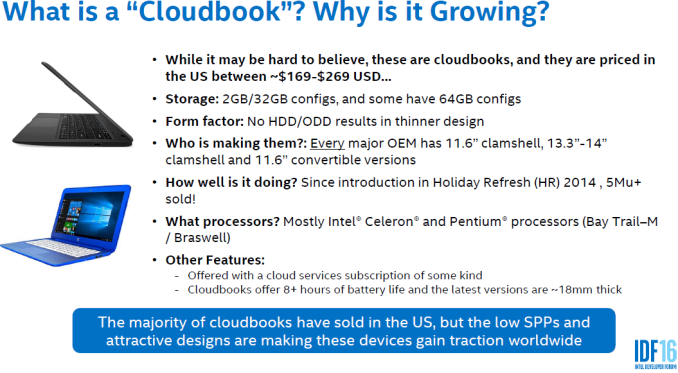
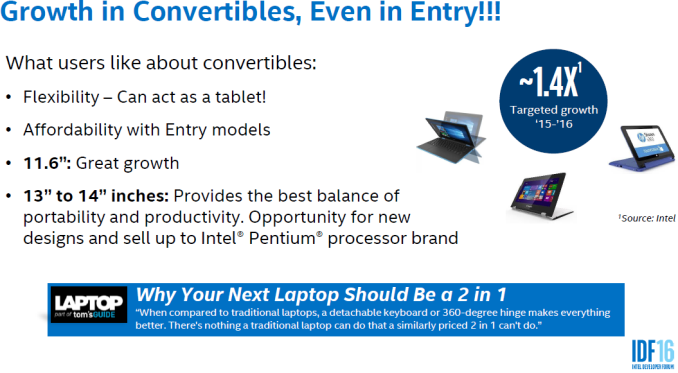














95 Comments
View All Comments
Arnulf - Saturday, April 16, 2016 - link
Assuming they don't gimp the platform (with locked UEFI/bootloader restricted to W10) once again like they did with previous incarnation(s) of Atom.Michael Bay - Saturday, April 16, 2016 - link
Dream on. This cheap thing will live or die on software, which means Windows only.MonkeyPaw - Friday, April 15, 2016 - link
The problem for Intel is that they don't really want Atom to be too good. If it is, then the Core line suffers as more people buy good-enough Atom-based systems. ARM SOC companies don't have this problem, as they are still mostly working to make their chips faster. Intel has superior fabrication equipment and probably the best engineers in the business, but the corporate machine spends so much energy making up SKUs with random features missing. I would love to see what Intel could really do with the Atom architecture, but I don't think we ever will.mrdude - Friday, April 15, 2016 - link
We're at a point where the x86 Intel alternative is the crap, poor-performing solution when compared to the ARM equivalent -- whether Snapdragon, A9, or even standard A72, they all outperform Intel's x86 SoC in performance, features, and often both.That's shameful.
Thatguy97 - Friday, April 15, 2016 - link
Well there's no competition, Intel is in absolutely no hurrymrdude - Friday, April 15, 2016 - link
That argument worked when they were rolling in the money, but that's not the case anymore. Intel made 58% of their revenue from the PC market in 2015, and that's a shrinking pie. If Intel isn't providing incentive and innovating in order to spur more sales -- completely irrespective of competition in the marketplace -- then they'll suffer because of it.And that's only in the high-end x86 space where there isn't competition. The two comments above you are within the context of the low power 'mobile' space where Intel has been spanked, bullied, and robbed of their lunch money. The issue there wasn't the lack of competition, but *the competition*
rahvin - Tuesday, April 19, 2016 - link
And yet, Intel still makes more money on Silcon than anyone else in the industry. We'll see more failures in the ARM segment before Intel is ever at risk. Their margins are still pushing 58% while most ARM producers are in the 3-8% range.Michael Bay - Saturday, April 16, 2016 - link
>outperformLaughable. Thow anything actually complex at ARM and it dies while boiling itself.
name99 - Saturday, April 16, 2016 - link
That's nonsense. Apple's CPUs outperform Skylake-m at equivalent powers, with more consistent lack of throttling, and with a substantially superior GPU performance.With the A8 Apple basically matched Intel at i3-level in IPC on-core, but still had some throttling issues. With the A9, Apple improved that to match Intel at the i7-level for IPC, both on-core AND in the uncore, substantially reduced throttling, and substantially ramped up frequency.
Intel has, right now, only one advantage at equivalent power; namely that Intel can still turbo its low power chips to ~3GHz for very short spurts, which provides some level of snappiness and reduced latency. I suspect that they will retain that for a while, because I think Apple has access to more low-lying fruit than adding turbo-ing circuitry, basically improvements that can materially improve their IPC over Intel while also slowly ramping up their frequency.
Of course Apple is sui generis, and doesn't sell on the open market. But their success acts as a continual spur to both ARM itself, and to the ARM independents like QC and nV. The cadence of ARM improvements is quite a bit faster than the pathetic 3% or so annual x86 improvement; and I think it will persist, especially once some sort of rationality and consolidation takes over the ARM market. (Right now it is crazy that nV, QC, Samsung, AMD, and various server companies like Applied Micro and Cavium are all trying to create basically the exact same sort of CPU. At some point this should consolidate to maybe ARM, QC, and Apple as the three CPU design companies, with talent spread across them much less thinly.)
lilmoe - Saturday, April 16, 2016 - link
"Apple's CPUs outperform Skylake-m at equivalent powers"lol